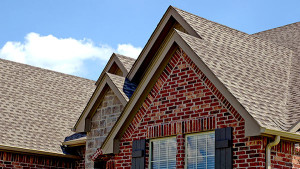Your roof may be aging faster than you realize

The roof of your home is its first line of defense against the elements.
But as a roof ages, its ability to protect lessens.
The manufacturer’s estimated lifetime rating for roof shingles is determined under ideal circumstances,
but actual conditions that your roof endures could be far from ideal.
We want to hear about it if your roof was recently replaced!
Help us update your insurance portfolio by calling us to talk about your roof.
Storm damage
Storm damage in the U.S. continues to escalate, with hail being a major cause of roof damage.
Nearly all supercell thunderstorms produce hail, ranging
from pea-sized to baseball-sized or larger. A hail‑producing
storm moving through a residential area can cause widespread roof damage.
Many factors can quickly affect the lifetime of a roof shingle:
- improper installation
- improper ventilation
- slope of the roof
- overall climate
Proper maintenance of your roof, chimney, flashing, vents and
gutters can slow the deterioration of your roof.
Protect your home
Here are some things you can do to protect your roof
and your investment in your home:
- Inspect your roof regularly so that you can address small problems
- quickly, avoiding costly roof failures down the road.
- Watch for conditions that may indicate a problem, such as:
- Curling, lifting, clawing, granular loss and other deterioration of shingles
- The presence of moss or algae
- Waves or ridges in the roof line; these can indicate a problem with the roof decking or framing.
Replace your roof when condition or age indicates
it may be losing its ability to divert moisture.
Replacing an aging roof can help maintain your home’s top defense.
If you replace your roof, please let Anders, Ireland, & Marshall
know immediately to assure that your home is insured for the correct value.
Claims
Finally, if you have a roof claim, look for a local, established
contractor to do any necessary repairs. Be careful of unusually
low bids – a roof is a major investment and a major protective feature of your home.
More information: Types of roofing
The types of roofing material can determine a roof’s ability to resist damage.
While this is a fixed feature of an existing home, you may be able
to make choices when building a new home that will make maintenance easier later on.
Shingles – The increase in the cost of shingles has outpaced
inflation in recent years. The lifespan of shingle roofs varies from 10 to
30 years depending on the type of shingles used, the area of the country a
nd the skill of the installers:
- Asphalt shingles are generally the least expensive roofing material option
- Composite shingles are made of asphalt combined with other materials such as fiberglass or other polymers. They are more expensive but can last longer. Composite shingle products can resemble asphalt, wood shake or slate and generally have advantages over each of those materials (less damageable than asphalt, more fire resistant than wood and less expensive than slate).
Metal – Metal roofing can cost about twice that of an asphalt
shingle roof. Modern metal roofs last 20 to 50 years, depending on the coating and conditions.
Wood – Wood shingles are popular in some parts of the country. While they cost two to three
times the cost of asphalt shingles, they have a lifespan of 20 to 30 years. Maintenance is a
key to wood roof life, as moisture buildup must be avoided. The fire exposure is an issue as
well, and your insurer may require an inspection before binding coverage.
Tile – Clay and concrete tile roofs are popular in parts of the South and West. Tile roofs can last
up to 50 years, but are heavy and cost four to five times the cost of an asphalt shingle roof.
Slate – Slate is the heaviest and most expensive, but longest lasting roofing material.
Slate roofs can last nearly 100 years.
Proper installation can extend the functional life of a roof, regardless of the materials. Several factors come into play:
- A more steeply sloped roof can resist storm damage somewhat better than a flatter roof.
- Ventilation is an often-overlooked aspect of roof installation. A poorly-ventilated roof permits the buildup of moisture and excessive attic heat.
- Roofs with multiple layers are more susceptible to damage due to moisture buildup/softening, excessive weight, poor sealing of shingles and insufficient ventilation.
- Beware of roofs installed with vertical racking, where the shingle edges run in straight lines up a roof, rather than being staggered. This can result in poor sealing of shingles and lifting of corners.
- Insufficient or poorly installed decking can increase moisture exposure, low spots which pool water, improper runoff and dry rot.
By Vicki W. Hill
https://blog.cinfin.com/2015/05/28/roof-may-be-aging/